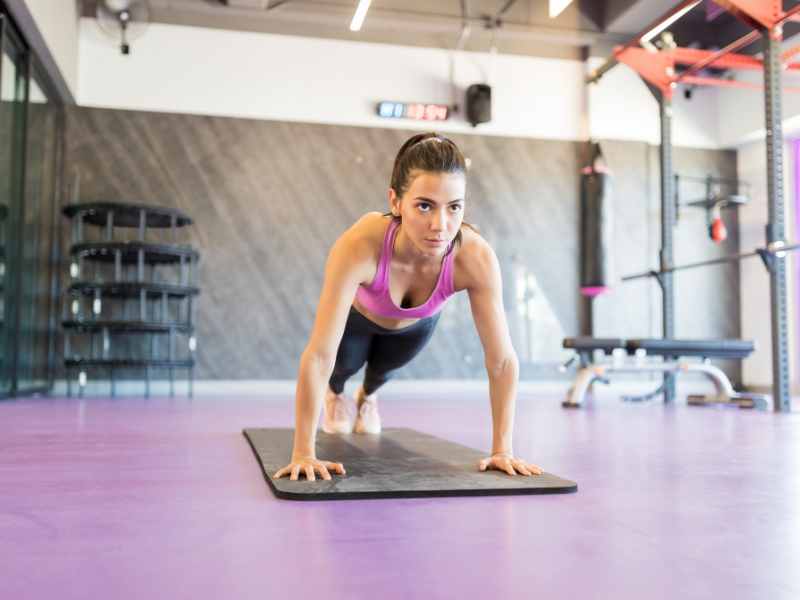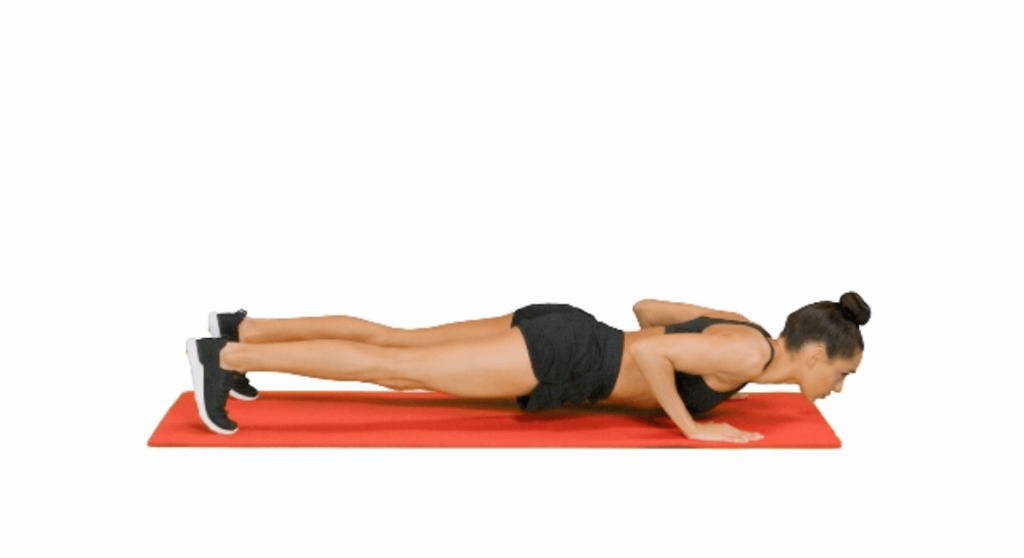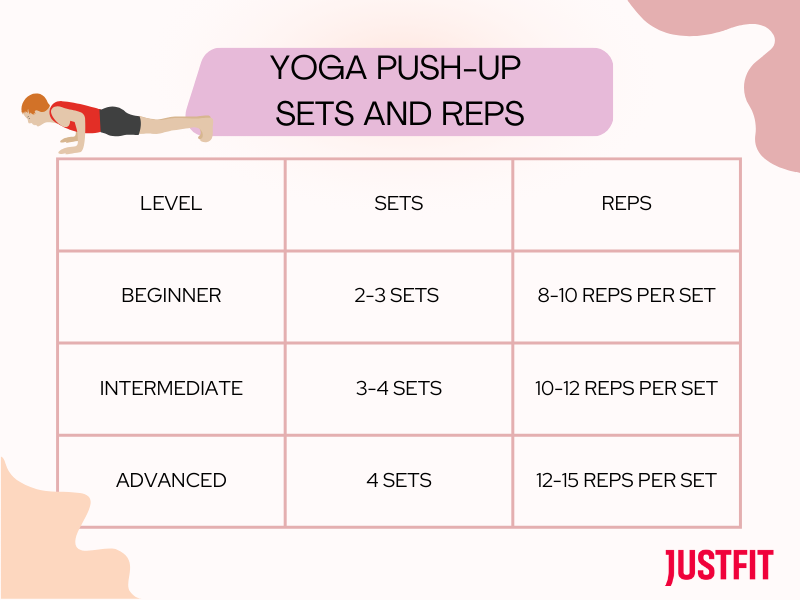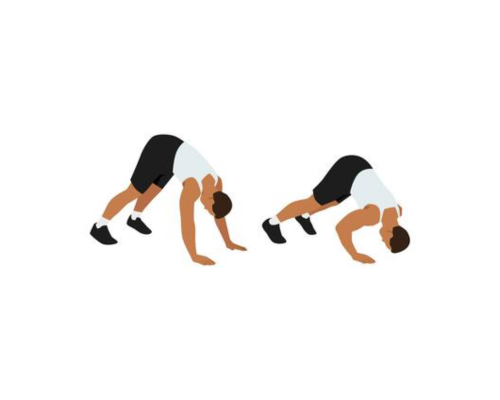




Are you ready to master the art of the challenging yet rewarding yoga push-up? The yoga push-up is often a key component of the sun salutation sequence, which helps energize the body and prepare the muscles for a yoga practice.
Picture yourself flowing smoothly from a strong plank position into a controlled, graceful descent, engaging your core, arms, and shoulders with precision and intention. Prepare to uncover the transformative potential of this foundational pose and deepen your connection between body and breath. Let’s embark on this empowering journey together and unlock the full benefits of the yoga push-up!
Key Takeaways

- Muscles Targeted: The primary muscles worked during yoga push-ups include the chest, with the secondary engagement of the abs, shoulders, and triceps.
- Proper Form: Maintaining proper form, including elbows close to the body, straight back, and controlled movement, is crucial for maximizing the benefits of yoga push-ups while minimizing the risk of injury.
- Sets and Reps: Beginners can start with 2-3 sets of 8-10 reps, intermediate level can aim for 3-4 sets of 10-12 reps, and advanced practitioners can challenge themselves with 4 sets of 12-15 reps.
- Benefits: Incorporating yoga push-ups into your routine strengthens upper body muscles, enhances core stability, improves shoulder stability, increases mind-body awareness, boosts metabolism, improves posture, enhances functional strength, and promotes a strong mind-body connection.
- Variations: Different variations, such as the pike push-up, diamond push-up, and the classic yoga push-up, offer options to target specific muscle groups or add variety to your workout routine.
- Yoga Classes: Participating in yoga classes can deepen the understanding of foundational poses like Chaturanga. These classes cater to different fitness levels and provide a structured environment for practicing various yoga movements, enhancing overall strength and flexibility.
What Muscles Does Yoga Push-Up Work?
The yoga push-up, also known as Chaturanga Dandasana, primarily targets the following muscles:
Shoulders (Deltoids)
The shoulders are heavily engaged as you stretch because they are responsible for stabilizing and lowering the body during the descent phase of the yoga push-up.
Chest (Pectoralis Major)
The chest muscles are engaged to support and control the movement of lowering the full body weight toward the floor in a controlled manner, adding to upper body strength.
Triceps
The triceps muscles are activated as they work to extend and bend the elbows and push the body back up to the starting position.
Core Muscles

The entire core, including the abdominals and lower back muscles, must engage to maintain proper alignment and stability throughout the movement. Additionally, engaging the hip flexors is crucial for maintaining proper form and maximizing the effectiveness of the yoga push-up, targeting multiple muscle groups including the core, hamstrings, and glutes [1].
Serratus Anterior
This muscle is crucial for stabilizing the shoulder blades and is activated during the protraction of the shoulder blades in the yoga push-up [2].
Practicing Chaturanga is instrumental in building upper body strength, which is essential for more complex yoga poses.
How to perform yoga push-ups

It’s important to recognize that the yoga push-up differs from the standard push-up commonly performed in gyms or fitness classes. Understanding these differences can help you maintain proper alignment, maximize the benefits of the exercise, and minimize the risk of injury. Here are the steps to execute a yoga push-up:
- Starting Position: Begin in a plank position with hands shoulder-width apart, wrists under shoulders, and feet tucked under, creating a straight line from head to heels.
- Engage Core: Tighten your core by drawing your stomach towards your spine, keeping your body straight.
- Lowering Phase: Slowly lower your body while keeping elbows close to your ribs and your upper arms parallel to the floor, forming a 90-degree angle at the elbows.
- End Position: Hold in the low plank (Chaturanga) for a moment, ensuring alignment and engagement.
- Upward Phase: Push through your palms to return to the starting plank position, keeping your legs straight and core engaged.
- Repeat: Perform several controlled repetitions, maintaining proper alignment throughout with your lower and upper body.
- Advanced Variation: For those who have mastered the basic pose, enhance your practice by lifting one leg off the mat during the transition into more challenging variations.
Remember to breathe deeply and listen to your body’s limits while performing yoga push-ups to avoid strain or injury.
Sets And Reps
For yoga push-ups, you can start with the following recommendations for sets and reps:

Feel free to adjust the number of sets and reps based on your fitness level and goals. Focus on maintaining proper form and controlled movement throughout each repetition. Additionally, you can incorporate yoga push-ups into your regular workout routine or yoga practice to build strength and endurance in your upper body and core muscles.
Yoga Push Up Variations
Yoga push-up variations offer a diverse range of challenging movements that not only target your upper body strength but also engage your core, balance, and flexibility. Incorporating different push-up variations can significantly enhance muscle strength, tone, and cardiovascular fitness. Here are descriptions of two different variations of push-ups:
Pike Push-Up

- To execute a pike push-up, begin in a downward dog pose, ensuring your hands are slightly wider than shoulder-width apart and your hips are raised high.
- Descend by bending your elbows close to your body to lower your head towards the ground.
- Press back up to the starting position by straightening your arms.
Diamond Push-Up

- Commence by assuming a plank position, with your hands positioned close together directly under your chest to create a diamond shape with your thumbs and index fingers.
- Lower your body towards the floor by bending the elbows, maintaining their proximity to your sides.
- Push back up to the starting position by straightening your arms.
These variations provide options to target different muscle groups or add variety to your workout routine. You can incorporate these variations into your regular workout routine to challenge yourself and continue progressing in your strength and fitness goals.
You may also like:
Face Yoga Exercises PDF: The Ultimate Guide
More Yoga-Based Workouts
If you enjoy exercises that stimulate rejuvenation and relaxation while also activating your muscles groups, try out the workout videos below for your different needs.
Recover and Restore Workouts
For a set of exercises to set your mood right and mind calm, pick this. It is curated with relaxation techniques and mindfulness practices that is catered to have your muscles relax and be recharged
Easy Move Conditioning
This routine can serve as a great workout for conditioning your body with gentle cardio and exercises for flexibility and strength
Abs and Stretch Workout
Having a strong core goes a long way when it comes to executing yoga techniques. Therefore, to strengthen your midsection and stretch all the right body parts, check out this routine.
Benefits Of Yoga Push Up

The yoga push-up offers a variety of benefits for both the body and mind. Here are some key benefits of practicing yoga with push up variations:
Strengthens Upper Body Muscles: Yoga push-ups target the chest, shoulders, triceps, and core muscles, helping to build strength and endurance in these areas.
Improves Core Stability: The engagement of the core muscles during yoga push-ups helps to improve overall core strength and stability, which is essential for maintaining proper posture and balance [3].
Enhances Shoulder Stability: By engaging the shoulder muscles and stabilizing them in the lowered position, yoga push-ups help enhance shoulder stability and reduce the risk of injuries.
Increases Mind-Body Awareness: Practicing yoga push-ups requires focus and concentration on proper alignment and breath control, promoting mindfulness and awareness of your body’s movements [4].
Boosts Metabolism: Performing yoga push-ups can help increase heart rate and boost metabolism, making it a beneficial exercise for calorie burning and weight management.
Incorporating yoga push-ups into your fitness routine can provide a wide range of physical and mental benefits, helping you improve strength, stability, and body awareness.
Conclusion
The yoga push-up is a highly effective compound exercise that targets various muscle groups simultaneously, providing a challenging and beneficial total body workout. By engaging muscles such as the chest, shoulders, triceps, core, and serratus anterior, the yoga push-up helps build strength, stability, and endurance while promoting proper alignment and muscle control. If you would like to learn about more workout that activate different parts of your body, check out the JustFit app!
What are yoga push ups good for?
What is a yoga push up called?
How can I modify the Chaturanga pose if I am not able to perform it yet?
Cleveland Clinic. (2024, July 23). 5 yoga poses you can do right now to strengthen your core. Cleveland Clinic. Available at: https://health.clevelandclinic.org/yoga-poses-that-can-strengthen-your-core-muscles
Holte, A. (n.d.). Mindfulness and yoga: Complementary paths of health, healing, and Wellbeing. Mindfulness and Yoga: Complementary Paths of Health, Healing, and Wellbeing | Centers for Integrative Health. Available at: https://cih.ucsd.edu/index.php/mbpti/blog/mindfulness-and-yoga-complementary-paths-health-healing-and-wellbeing
Miller, K. (2018, February 13). What are your scapulae doing in a push up?. Musicians’ Health Collective. Available at: https://www.musicianshealthcollective.com/blog/2018/2/13/what-are-your-scapula-doing-in-a-push-up
YJ Editors. (2024, March 27). 6 yoga poses for stretching tight hip flexors. Yoga Journal. Available at: https://www.yogajournal.com/poses/anatomy/hip-flexors/stretch-tight-hip-flexors/





